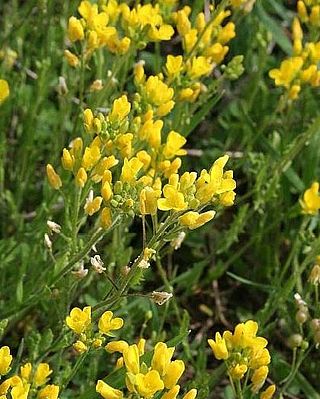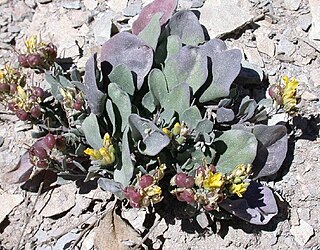Bladderpod oil is a seed oil, extracted from the seeds of the Physaria fendleri and other species of genus Physaria, Native to the plains and mesas of southwestern United States, eastward to Kansas and southward into northern Mexico. Bladderpod oil is rich in lesquerolic acid (C20:1-OH), a rare hydroxycarboxylic acid. The only commercial source of hydroxycarboxylic acids is ricinoleic acid (C18:1-OH), found in castor oil. Essentially all castor oil production in the U.S. has been eliminated by a combination of economic factors, excessive allergenic reactions of field and processing workers, and toxicity of the seed meal. The fatty acid composition of bladderpod oil is:

Physaria fendleri is a species of flowering plant in the family Brassicaceae known by several common names, including Fendler's bladderpod, popweed, and lesquerella.
Bladderpod is a common name for several plants and may refer to:

Physaria is a genus of flowering plants in the family Brassicaceae. Many species are known generally as twinpods, bladderpods, or lesquerella. They are native to the Americas, with many species endemic to western North America. They are densely hairy annual and perennial herbs often growing prostrate or decumbent, along the ground in patches or clumps. They bear inflorescences of bright yellow flowers. The fruit is often notched deeply, dividing into twin sections, giving the genus its common name.

Paysonia lyrata is a rare species of flowering plant in the family Brassicaceae known by the common name lyreleaf bladderpod. It is endemic to Alabama in the United States, where it is known from only three occurrences. It is federally listed as a threatened species.

Physaria filiformis is a rare species of flowering plant in the family Brassicaceae known by the common names Missouri bladderpod and limestone glade bladderpod. It is native to Missouri and Arkansas in the United States. It was federally listed as an endangered species in 1987 and it was downlisted to threatened status in 2003. P. filiformis remains listed as an endangered species at the state level in Missouri.
Physaria parviflora is a species of flowering plant in the family Brassicaceae known by the common names Piceance bladderpod and frosty bladderpod. It is endemic to Colorado in the United States, where it occurs in Garfield, Mesa, and Rio Blanco Counties.

Paysonia stonensis is a species of flowering plant in the family Brassicaceae, known by the common name Stones River bladderpod. It is endemic to Tennessee in the United States, where it is limited to Rutherford County. It grows only in the floodplains of the Stones River, and certain tributaries.

Paysonia is a genus of flowering plants in the family Brassicaceae. They are generally referred to by the common name bladderpod or mustard. The genus is found in southern North America. Until 2002 it was considered to be part of the genus Lesquerella but was separated based on genetic and morphological features.
Physaria fremontii is a species of flowering plant in the family Brassicaceae known by the common name Fremont's bladderpod. It is endemic to Wyoming in the United States, where it occurs only in and around the Wind River Range in Fremont County.

Physaria tenella is a species of flowering plant in the family Brassicaceae known by the common names Moapa bladderpod and slender bladderpod. It is native to western North America from Utah to Sonora, where it grows mainly in desert habitat. This is an annual herb producing several hairy multibranched erect to spreading stems sometimes exceeding half a meter long. The basal leaves are up to 6.5 centimeters long and sometimes toothed, and there are smaller leaves higher on the stem. The inflorescence is a raceme of flowers at the tip of the stem. The mustardlike flower has four orange to bright yellow petals each up to a centimeter long. The fruit is a plump, hairy, rounded capsule containing flat orange seeds.

Physaria pallida is a rare species of flowering plant in the mustard family known by the common name white bladderpod. It is endemic to Texas in the United States, where it is known only from San Augustine County. It is federally listed as an endangered species.

Physaria congesta is a rare species of flowering plant in the mustard family known by the common name Dudley Bluffs bladderpod. It is endemic to western Colorado in the United States, where it is known only from seven occurrences in Rio Blanco County. It is federally listed as a threatened species.

Physaria parvula is a species of flowering plant in the family Brassicaceae known by the common name pygmy bladderpod. It is native to the Western United States, where it can be found in Colorado, Utah, and Wyoming.

Physaria pruinosa is a species of flowering plant in the family Brassicaceae known by the common names Pagosa Springs bladderpod and frosty bladderpod. It is native to Colorado and New Mexico in the United States.

Physaria thamnophila is a rare species of flowering plant in the mustard family known by the common name Zapata bladderpod. It is native to Texas in the United States, where it is known from Zapata and Starr Counties. The plant is threatened by the loss and degradation of its habitat. It is federally listed as an endangered species.

Physaria tumulosa is a rare species of flowering plant in the family Brassicaceae known by the common name Kodachrome bladderpod. It is endemic to Utah in the United States, where it is known only from Kane County. There is only one known population of this plant made up of scattered occurrences totalling about 20,000 individuals, all within the Kodachrome Basin. The plant is threatened by the loss and degradation of its habitat. It is federally listed as an endangered species. It was previously treated as a subspecies of Physaria hitchcockii.

Physaria arctica is a perennial flowering herb in the family Brassicaceae, known by the common name arctic bladderpod.
Physaria gordonii, commonly known as Gordon's bladderpod, is a species of plant in the family Brassicaceae distributed throughout the Southwestern United States and Northern Mexico. It is a winter annual wildflower, maturing between April and June. The plant normally grows in sandy or gravel deserts. The plant has low-growing stems, with long, lanceolate leaves measuring about 4 in (10 cm). The plants flowers are in a loose, raceme cluster, and are radially symmetrical. The plant is very similar to P. fendleri.

Physaria ludoviciana is a species of flowering plant in the mustard family Brassicaceae, with the common names of bladder pod, silver bladderpod, louisiana bladderpod, and foothill bladderpod. It used to be Lesquerella ludoviciana which is now a synonym.















